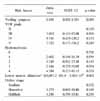Abstract
Purpose
Endoscopic subureteral injection of dextranomer/hyaluronic acid copolymer (Deflux®) has become an established alternative to long-term antibiotic prophylaxis and open ureteral reimplantation for the management of vesicoureteral reflux (VUR) in children. We retrospectively evaluated the risk factors for treatment failure after endoscopic correction of VUR.
Materials and Methods
Between 2005 and 2007, 23 boys and 26 girls (total of 69 ureters) with VUR underwent endoscopic subureteral injection of Deflux® primarily. VUR was unilateral in 29 patients and bilateral in 20 patients. Of the 69 ureters, VUR was grade II to V in 13, 28, 20, and 8, respectively. Follow-up urinalysis and ultrasonography were performed 1 and 3 months after the procedure, and a voiding cystourethrogram was performed at 6 or 9 months postoperatively.
Results
Treatment failure was defined as persistent VUR of grade II or over grade II. Endoscopic correction failed in 22 of 69 refluxing ureters. Age, sex, laterality, number of preoperative urinary tract infections, time from diagnosis to operation, presence of renal scarring, and injection volume did not influence outcome. However, preoperative presence of voiding symptoms, high-grade reflux and hydronephrosis, and having a horseshoe or golf-hole shaped ureteral orifice had a negative influence on the treatment result by univariate analysis. Severe dilatation of the lower ureter was the only statistically significant factor by multivariate analysis.
Conclusions
Severity of lower ureteral dilatation is the most significant factor influencing the failure of endoscopic subureteral injection of Deflux®. Other factors significantly involved in failure are the presence of voiding symptoms, high-grade reflux and hydronephrosis, and a horseshoe or golf-hole shaped ureteral orifice. Success rates may improve if we carefully consider these influencing factors before choosing an operative method.
References
1. Jacobson SH, Hansson S, Jakobsson B. Vesico-ureteric reflux: occurrence and long-term risks. Acta Paediatr. 1999. 88:22–30.
2. Puri P. Endoscopic correction of vesicoureteral reflux. Curr Opin Urol. 2000. 10:593–597.
3. Tamminen-Mobius T, Brunier E, Ebel KD, Lebowitz R, Olbing H, Seppanen U, et al. Cessation of vesicoureteral reflux for 5 years in infants and children allocated to medical treatment. The International Reflux Study in Children. J Urol. 1992. 148:1662–1666.
4. Bailey RR, Maling TM, Swainson CP. Schrier RW, Gottschalk CW, editors. Vesicoureteric reflux and reflux nephropathy. Diseases of the kidney. 1993. 5th ed. Boston: Little, Brown & Co.;687–727.
5. Bisignani G, Decter RM. Voiding cystourethrography after uncomplicated ureteral reimplantation in children: is it necessary? J Urol. 1997. 158:1229–1231.
6. Lorenzo AJ, Pippi Salle JL, Barroso U, Cook A, Grober E, Wallis MC, et al. What are the most powerful determinants of endoscopic vesicoureteral reflux correction? Multivariate analysis of a single institution experience during 6 years. J Urol. 2006. 176:1851–1855.
7. Dawrant MJ, Mohanan N, Puri P. Endoscopic treatment for high grade vesicoureteral reflux in infants. J Urol. 2006. 176:1847–1850.
8. Puri P, Pirker M, Mohanan N, Dawrant M, Dass L, Colhoun E. Subureteral dextranomer/hyaluronic acid injection as first line treatment in the management of high grade vesicoureteral reflux. J Urol. 2006. 176:1856–1860.
9. Joyner BD, Atala A. Endoscopic substances for the treatment of vesicoureteral reflux. Urology. 1997. 50:489–494.
10. Bhatti HA, Khattak H, Boston VE. Efficacy and causes of failure of endoscopic subureteric injection of Teflon in the treatment of primary vesicoureteric reflux. Br J Urol. 1993. 71:221–225.
11. Smith DP, Kaplan WE, Oyasu R. Evaluation of polydimethylsiloxane as an alternative in the endoscopic treatment of vesicoureteral reflux. J Urol. 1994. 152:1221–1224.
12. Cukier J, Beauchamp RA, Spindler JS, Spindler S, Lorenzo C, Trentham DE. Association between bovine collagen dermal implants and a dermatomyositis or a polymyositis-like syndrome. Ann Intern Med. 1993. 118:920–928.
13. Stenberg A, Läckgren G. A new bioimplant for the endoscopic treatment of vesicoureteral reflux: experimental and short-term clinical results. J Urol. 1995. 154:800–803.
14. Méndez R, Somoza I, Tellado MG, Liras J, Sanchez A, Paris E, et al. Predictive value of clinical factors for successful endoscopic correction of primary vesicoureteral reflux grades III-IV. J Pediatr Urol. 2006. 2:545–550.
15. Kirsch AJ, Perez-Brayfield MR, Scherz HC. Minimally invasive treatment of vesicoureteral reflux with endoscopic injection of dextranomer/hyaluronic acid copolymer: the Children's Hospitals of Atlanta experience. J Urol. 2003. 170:211–215.
16. Capozza N, Lais A, Matarazzo E, Nappo S, Patricolo M, Caione P. Influence of voiding dysfunction on the outcome of endoscopic treatment for vesicoureteral reflux. J Urol. 2002. 168:1695–1698.
17. Park YH, Kim KM. Dextranomer/hyaluronic acid copolymer (Deflux®) injection for vesicoureteral reflux in children: the efficacy and safety. Korean J Urol. 2007. 48:620–626.
18. Lavelle MT, Conlin MJ, Skoog SJ. Subureteral injection of deflux for correction of reflux: analysis of factors predicting success. Urology. 2005. 65:564–567.
19. Puri P, Chertin B, Velayudham M, Dass L, Colhoun E. Treatment of vesicoureteral reflux by endoscopic injection of dextranomer/hyaluronic acid copolymer: preliminary results. J Urol. 2003. 170:1541–1544.
20. Routh JC, Vandersteen DR, Pfefferle H, Wolpert JJ, Reinberg Y. Single center experience with endoscopic management of vesicoureteral reflux in children. J Urol. 2006. 175:1889–1893.
21. Elmore JM, Scherz HC, Kirsch AJ. Dextranomer/hyaluronic acid for vesicoureteral reflux: success rates after initial treatment failure. J Urol. 2006. 175:712–715.
22. Somoza I, Vela D, Liras J, Méndez R, Tellado MG, Abuín AS, et al. Success of endoscopic management in vesicoureteral reflux, conditioned by ureteral dilatation. Cir Pediatr. 2003. 16:90–94.
23. Park SY, Park HY, Woo YN. The factors affecting the outcome after medical management of vesicoureteral reflux. Korean J Urol. 2006. 47:994–1000.




 PDF
PDF ePub
ePub Citation
Citation Print
Print




 XML Download
XML Download